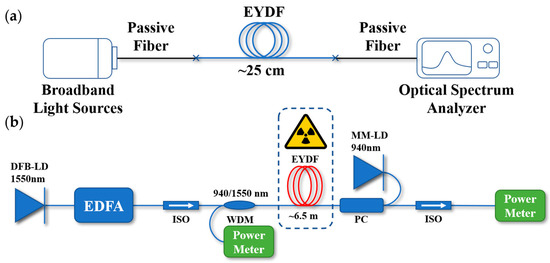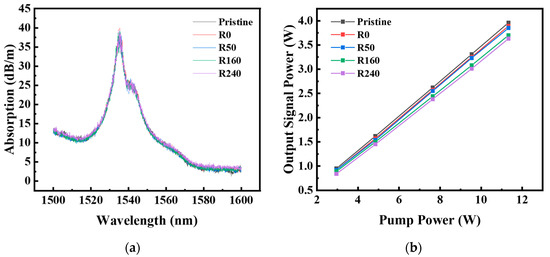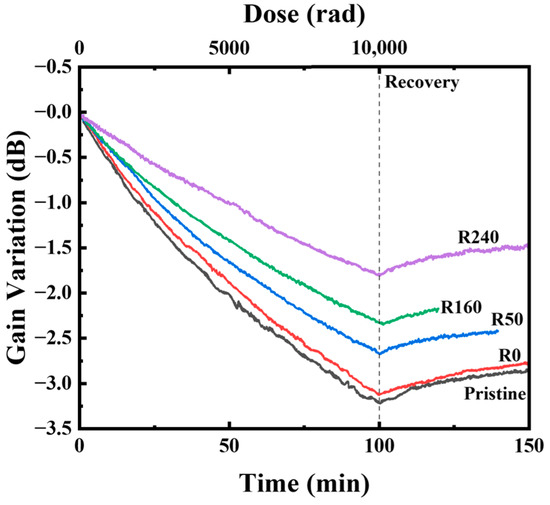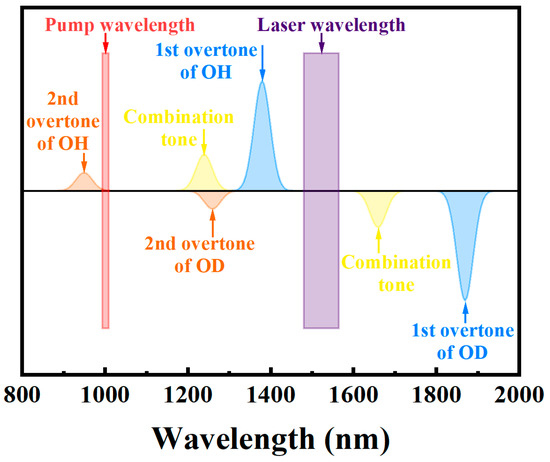Abstract
In this study, a pretreatment method for improving the radiation resistance of Er-Yb co-doped silica fiber (EYDF) is proposed. EYDF is the object in this method and is processed by two steps, including deuterium loading and pre-irradiation. The effects of pretreatment conditions on the laser performance and radiation resistance of EYDF were systematically studied. An online irradiation experiment setup was utilized to evaluate the radiation resistance of EYDF. The results demonstrate that the pretreatment can significantly improve the radiation resistance of EYDF, with minimal impact on the laser output power and slope efficiency. Specifically, the radiation-induced gain variations in the pristine fiber and the pretreated fiber with a cumulative dose of 240 krad were 3.13 dB and 1.81 dB, respectively. Additionally, the high-vacuum experiments show that the proposed pretreatment method can maintain a long-term stable radiation resistance improvement in the fiber. This study provides a method to improve the radiation resistance of EYDF for space applications.
1. Introduction
Over the past few decades, Er-Yb co-doped fiber (EYDF) and its amplifier (EYDFA) have been widely used in various fields such as LiDAR [1,2,3], atmospheric detection [4,5], remote sensing [6,7,8], space optical communication [9,10,11], deep space detection [12], and other fields due to their exceptional signal amplification and laser performance near the 1.55 μm band. However, when the device is exposed to harsh radiation in the space environment, its output power declines sharply [13]. A study has confirmed that during the irradiation process, the increasing loss of the active fiber in the device is the primary reason for the reduction in output power [14]. Co-doped elements such as Al and P are generally incorporated in active fibers to inhibit clusters or improve laser performance [15]. However, these elements tend to induce the formation of color centers during the irradiation process [16], leading to additional absorption bands. Some of these absorption bands will cover the operating laser wavelength of the active fiber, thus directly affecting its laser performance [17].
In order to improve the radiation resistance of EYDF, several methods have been proposed [18]. Early studies have established that Ce co-doping can significantly improve the radiation resistance of active fiber [13,19,20,21] and is widely used in the preparation of radiation-resistant fiber. Furthermore, loading H2/D2 in the active fiber core can also significantly improve the radiation resistance of the active fiber [19,22,23,24,25]. The gas loading process is compatible with the Ce co-doping process and can be simultaneously used to further improve its radiation resistance. Nevertheless, H2/D2 molecules can easily escape from the fiber at normal temperatures and pressures, and their radiation resistance decreases significantly after several weeks [23,26]. To suppress gas escape, Zotov et al. proposed a method that employs carbon coating [23], which prolongs the life span of H2-loaded fiber several times. Girard et al. further proposed a hole-assisted carbon-coated structure [24,26] that loads H2/D2 into the fiber core through the air holes in the cladding, reducing the radiation sensitivity of the erbium-doped fiber amplifier (EDFA) to 2.2 mdB/krad. However, these methods have additional requirements for the special fiber structure. Furthermore, it is too complicated and challenging to prepare a double-clad structure fiber [24].
In previous studies [27,28,29], it was found that the hydroxyl (OH-) groups generated in the H2-loaded fiber can improve the radiation resistance of pure silica fibers to a certain extent. However, these groups were found to seriously affect the laser performance of EYDF [30]. Since hydrogen and deuterium are isotopes, an erbium-doped fiber (EDF) preform pretreated by D2 loading, pre-irradiation, and thermal annealing was drawn into the fiber and tested in some previous studies [31,32]. It was confirmed that D2 solidified in the fiber core with the deuteroxyl (OD-) form after pre-irradiation. OD- was found to improve the radiation resistance of YDF and EDF to some extent while having little impact on the laser performance of the fiber. However, the preform pretreatment method must be used in the fiber preparation process, which is inconvenient compared to a fiber pretreatment method, and the effect of OD- groups on the laser performance and radiation resistance of EYDF has not been reported.
In this paper, in order to improve the radiation resistance of active fiber, referring to the preform pretreatment method in previous studies [31,32], homemade EYDFs were pretreated directly by two steps, including D2 loading and pre-irradiation. The pretreated fibers were subjected to vacuum treatment to facilitate the escape of free D2 molecules in the fiber. The effect of pretreatment on the laser performance and radiation resistance of EYDFs was studied by comparing the absorption, laser performance, and radiation resistance of the pristine and pretreated fibers.
2. Experimental Details
A homemade radiation-resistant Er/Yb/P/Al/Ce co-doped silica fiber with a double-clad octagonal geometry was prepared using MCVD technology, and the main available characteristics of the fiber are reported in Table 1. The Ce was co-doped to improve its radiation resistance.

Table 1.
Characteristics of the EYDF.
The flowchart of the pretreatment method is presented in Figure 1, and the fibers were divided into five groups for testing. One group was used for contrast experiment (labeled Pristine), while the other four groups underwent a D2 loading process at 60 °C and 5 MPa for 72 h (loaded under a high temperature and pressure to accelerate diffusion into the fiber core). Then, three of these groups were irradiated with X-rays at a dose rate of 1 krad/min with total doses of 50, 160, and 240 krad, respectively (to stabilize the D2 molecules in the fiber core and prevent diffusion out of the fiber). Finally, all D2-loaded fibers were placed in a vacuum environment of 50 °C and <1 Pa for 168 h (to verify whether D2 molecules were stable in the fiber). The groups of D2-loaded fibers were labeled R0, R50, R160, and R240 according to their pre-irradiation dose. Table 2 briefly describes the pretreatment differences between the five groups of fibers.

Figure 1.
Flowchart of the pretreatment method.

Table 2.
The pretreatment process corresponding to the five groups of fibers.
To investigate the effect of the pretreatment on the laser performance of EYDF, the absorption spectra and the slope efficiency of all fibers in the 1.55 μm band were measured. The setup used for the absorption test is illustrated in Figure 2a. The broadband light source was the stabilized tungsten–halogen light source (Thorlabs Inc., Newton, NJ, USA), the spectrometer was the optical spectrum analyzer (OSA, YOKOGAWA-AQ6370C), and the passive fiber was SMF-28e. The absorption spectra were measured using the cutback method. Figure 2b shows the setup used for the slope efficiency test, and the irradiation source was turned off. First, a 1.55 μm signal with a power of ~10 mW was generated by a distributed feedback laser diode (DFB-LD) and amplified to ~150 mW by the EDFA for subsequent tests. Then, the amplified signal was injected into the EYDF after passing through an isolator. The EYDF was pumped by a backward 940 nm multimode laser diode (MM-LD), with a maximum power of about 11.33 W. Finally, the output signal was obtained and tested by a power meter after passing through a high-power isolator.

Figure 2.
(a) The setup used for the absorption test; (b) the setup used for the efficiency and radiation resistance tests.
To assess the effect of the pretreatment on the radiation resistance of EYDF, an online irradiation experiment was set up, as shown in Figure 2b. The EYDFs were exposed to X-ray irradiation with a dose rate of 100 rad/min and a total dose of 10 krad, and variations of the output power during the process were recorded. X-ray was produced by a 160 kV and 3000 W X-RAD 160 X-ray source (Precision X-Ray Inc., Madison, CT, USA) with a tungsten target. Only the EYDF was exposed to X-rays during the online test to prevent any effect on the measurement instrument.
3. Results and Discussion
To evaluate the effect of pretreatment on the fibers, the absorption spectra and the slope efficiency were tested. The absorption spectra of the pristine and pretreated EYDFs at 1500–1600 nm are shown in Figure 3a. It was observed that the spectra of all fibers were similar, indicating that the spectral properties of the EYDF were not significantly affected by the pretreatment process. Figure 3b shows the output power of fibers with the increase in pump power. The output power of the pristine fiber can reach 3.96 W, with a slope efficiency of 35.9% under 11.33 W pumping. The output powers of the pretreated R0, R50, R160, and R240 fibers were 3.89 W, 3.85 W, 3.68 W, and 3.63 W, with slope efficiencies of 35.5%, 35.2%, 33.6%, and 33.2%, respectively, under the same test conditions. The fiber (R240) irradiated by a total dose of 240 krad resulted in a reduction of only 2.7% in the slope efficiency. These results suggest that the pretreatment slightly affects the laser performance of fibers.

Figure 3.
(a) The absorption spectra of all fibers near the 1.55 μm band; (b) slope efficiency of all fibers.
Figure 4 shows the gain variations in the EYDFs with an increasing cumulative X-ray dose. During the experiment, all conditions, such as the signal power, the pump power, and the length of EYDFs, remained the same. The output power of all groups was 2.4 ± 0.2 W before irradiation. After irradiation, the gain of the Pristine and R0 decreased by 3.22 dB and 3.12 dB, respectively. The gain variation in R0 was very close to Pristine, indicating that the D2 loaded in the fibers was entirely consumed during the vacuuming process. The gain variations in R50, R160, and R240 were 2.68 dB, 2.35 dB, and 1.81 dB, respectively. The gain variation in R240 was 1.4 dB lower than that of the pristine fiber, which confirms that the pretreatment method effectively improved the radiation resistance of EYDF. Furthermore, the radiation resistance was observed to improve with an increasing pre-irradiation dose. These results suggest that the pre-irradiation process made D2 molecules stable in the fiber, permanently improving its radiation resistance.

Figure 4.
Radiation-induced gain variation in the fibers.
According to a previous study [33], during irradiation, matrices in the rare-earth-doped silica glass (such as SiO2, Al2O3, and P2O5) can lead to the creation of color centers, introducing a new energy level for the energy band [34]. As a result, additional absorption is generated in the visible and near-infrared regions, and its extension can even cover 2 μm, including the operating laser wavelength of EYDF, thereby affecting its laser performance.
An improvement in the radiation resistance of the pretreated fiber was mainly related to OH- and OD- groups. As shown in Figure 5, the first and second overtone center wavelengths of OH- groups were located at 1.38 and 0.95 μm [35,36], respectively. Their extended bands covered the operating laser wavelength of Er3+ ions at ~1.55 μm and Yb3+ ions at ~1 μm, affecting the laser performance of EYDF. After loading D2 and pre-irradiation treatment, the unstable D2 molecules interacted with OH- to form new chemical bonds (such as Si-OD and Si-D) in the silica network [32], reducing the OH- group content. Although OD- group will also increase the absorption of the fiber, the first and second overtone center wavelengths of OD- groups were located at 1.89 and 1.26 μm [35,36,37], respectively. They were far away from the operating laser wavelength of EYDF compared to OH- groups. The OD- and D- groups in the glass network were unstable and easily photolyzed in the irradiation environment [31,38]. A study confirmed that deuterium radicals (D·) photolyzed by irradiation could effectively bleach the radiation-induced dangling bond defects [39]. Therefore, the pretreatment process can effectively suppress the creation of dangling bond defects in the fiber during irradiation.

Figure 5.
Main absorption peaks of OH- and OD- groups in the fiber.
4. Conclusions
In conclusion, a pretreatment method, involving deuterium loading and pre-irradiation, is proposed, which can permanently improve the radiation resistance of the EYDF without affecting its laser performance. By comparing the fiber core absorption spectrum and the slope efficiency, the pretreatment process will not significantly impact the laser performance of the fiber. The radiation resistance test proves that the pretreatment process can improve the radiation resistance of the fiber, and with the pre-irradiation dose increasing, the radiation resistance is improved. All pretreated fibers were treated in the same vacuum environment to evaluate the time stability of the radiation resistance. The results of the radiation resistance experiment show that the pretreatment can bring a permanent improvement in the radiation resistance of the fiber.
Author Contributions
Conceptualization, C.S. and C.Y.; methodology, Y.Z. and C.S.; validation, Y.Z. and C.S.; formal analysis, Y.Z., C.S. and C.Y.; investigation, Y.Z. and C.S.; resources, F.W, M.W., L.Z. and C.Y.; data curation, Y.Z.; writing—original draft preparation, Y.Z.; writing—review and editing, C.S., F.W., Y.D. and C.Y.; funding acquisition, C.S., C.Y. and L.H. All authors have read and agreed to the published version of the manuscript.
Funding
This research was funded by the National Natural Science Foundation of China (grant no. 62005297), the National Key Research and Development Program of China (grant no. 2020YFB1805900), and the Chinese Academy of Sciences (grant no. KGFZD-145-22-13).
Institutional Review Board Statement
Not applicable.
Informed Consent Statement
Not applicable.
Data Availability Statement
The data used to support the results of this study are available from the corresponding author upon request.
Conflicts of Interest
The authors declare no conflict of interest.
References
- Wang, C.; Xia, H.Y.; Shangguan, M.J.; Wu, Y.B.; Wang, L.; Zhao, L.J.; Qiu, J.W.; Zhang, R.J. 1.5 μm polarization coherent lidar incorporating time-division multiplexing. Opt. Express 2017, 25, 20663–20674. [Google Scholar] [CrossRef] [PubMed]
- Zha, S.Q.; Chen, Y.J.; Li, B.X.; Lin, Y.F.; Liao, W.B.; Zou, Y.Q.; Huang, C.H.; Lin, Z.L.; Zhang, G. High-repetition-rate 1.5 μm passively Q-switched Er:Yb:YAl3(BO3)4 microchip laser. Chin. Opt. Lett. 2021, 19, 6. [Google Scholar] [CrossRef]
- Yao, G.; Zhao, Z.G.; Liu, Z.J.; Gao, X.B.; Cong, Z.H. High repetition rate actively mode-locked Er:fiber laser with tunable pulse duration. Chin. Opt. Lett. 2022, 20, 6. [Google Scholar] [CrossRef]
- Yu, A.W.; Abshire, J.B.; Storm, M.; Betin, A. Laser Amplifier Development for IPDA Lidar measurements of CO2 from Space. In Proceedings of the Conference on Solid State Lasers XXIV—Technology and Devices, San Francisco, CA, USA, 8–10 February 2015. [Google Scholar]
- Yu, W.L.; Yan, P.; Qi, T.C.; Wu, Y.L.; Li, D.; Xiao, Q.R.; Gong, M.L. High-power and high-brightness Er:Yb codoped fiber MOPA operating at 1535 nm. Opt. Express 2022, 30, 16837–16846. [Google Scholar] [CrossRef] [PubMed]
- Wu, H.; Han, B.; Wang, Z.N.; Liang, H.K. Statistical properties of Er/Yb co-doped random Rayleigh feedback fiber laser. Chin. Opt. Lett. 2021, 19, 5. [Google Scholar] [CrossRef]
- Sergeyev, S.; Kolpakov, S.; Loika, Y. Vector harmonic mode-locking by acoustic resonance. Photonics Res. 2021, 9, 1432–1438. [Google Scholar] [CrossRef]
- Yang, Q.B.; Jiao, Y.; Yu, C.L.; Shao, C.Y.; Lou, F.G.; Wang, S.K.; Zhang, L.; Yang, Q.H.; Hu, L.L. Gain and laser performance of heavily Er-doped silica fiber fabricated by MCVD combined with the sol-gel method. Chin. Opt. Lett. 2021, 19, 5. [Google Scholar] [CrossRef]
- Song, D.Y.; Hurh, Y.S.; Cho, J.W.; Lim, J.H.; Lee, D.W.; Lee, J.S.; Chung, Y.C.; Chung, Y. 4 × 10 Gb/s terrestrial optical free space transmission over 1.2 km using an EDFA preamplifier with 100 GHz channel spacing. Opt. Express 2000, 7, 280–284. [Google Scholar] [CrossRef]
- Wang, J.; Yang, J.Y.; Fazal, I.M.; Ahmed, N.; Yan, Y.; Huang, H.; Ren, Y.X.; Yue, Y.; Dolinar, S.; Tur, M.; et al. Terabit free-space data transmission employing orbital angular momentum multiplexing. Nat. Photonics 2012, 6, 488–496. [Google Scholar] [CrossRef]
- Lin, Q.M.; Yan, L.; Song, Y.Q.; Jia, X.Z.; Feng, X.Q.; Hou, L.; Bai, J.T. Switchable single- and dual-wavelength femtosecond mode-locked Er-doped fiber laser based on carboxyl- functionalized graphene oxide saturable absorber. Chin. Opt. Lett. 2021, 19, 6. [Google Scholar] [CrossRef]
- Gupta, S.; Engin, D.; Pachowicz, D.; Fouron, J.L.; Lander, J.; Dang, X.; Litvinovitch, S.; Chuang, T.; Puffenberger, K.; Kimpel, F.; et al. Development, testing, and initial space qualification of 1.5-μm, high-power (6 W), pulse-position-modulated fiber laser transmitter for deep-space laser communication. Opt. Eng. 2016, 55, 9. [Google Scholar] [CrossRef]
- Aubry, M.; Morana, A.; Mescia, L.; Mekki, J.; Ranger, C.; Laurent, A.; Robin, T.; Marin, E.; Ouerdane, Y.; Boukenter, A.; et al. Combined Temperature and Radiation Effects on the Gain of Er- and Er–Yb-Doped Fiber Amplifiers. IEEE Trans. Nucl. Sci. 2021, 68, 793–800. [Google Scholar] [CrossRef]
- Chi, J.; Jiang, S.; Zhang, L.; Yu, M.; Wang, J. Experimental Study on Radiation Performance of Fiber Lasers. Laser Optoelectron. Prog. 2018, 55, 061406. [Google Scholar] [CrossRef]
- Jiao, Y.; Guo, M.T.; Wang, R.L.; Shao, C.Y.; Hu, L.L. Influence of Al/Er ratio on the optical properties and structures of Er3+/Al3+ co-doped silica glasses. J. Appl. Phys. 2021, 129, 9. [Google Scholar] [CrossRef]
- Girard, S.; Ouerdane, Y.; Tortech, B.; Marcandella, C.; Robin, T.; Cadier, B.; Baggio, J.; Paillet, P.; Ferlet-Cavrois, V.; Boukenter, A.; et al. Radiation Effects on Ytterbium- and Ytterbium/Erbium-Doped Double-Clad Optical Fibers. IEEE Trans. Nucl. Sci. 2009, 56, 3293–3299. [Google Scholar] [CrossRef]
- Shao, C.Y.; Ren, J.J.; Wang, F.; Ollier, N.; Xie, F.H.; Zhang, X.Y.; Zhang, L.; Yu, C.L.; Hu, L.L. Origin of Radiation-Induced Darkening in Yb3+/Al3+/P5+-Doped Silica Glasses: Effect of the P/Al Ratio. J. Phys. Chem. B 2018, 122, 2809–2820. [Google Scholar] [CrossRef]
- She, S.; Mei, L.; Zhou, Z.; Hou, C.; Guo, H. Progress in Radiation-Resistant Erbium-Doped and Erbium-Ytterbium Co-doped Fibers for Space Optical Communication. J. Appl. Sci. 2020, 38, 579–594. [Google Scholar] [CrossRef]
- Girard, S.; Vivona, M.; Laurent, A.; Cadier, B.; Marcandella, C.; Robin, T.; Pinsard, E.; Boukenter, A.; Ouerdane, Y. Radiation hardening techniques for Er/Yb doped optical fibers and amplifiers for space application. Opt. Express 2012, 20, 8457–8465. [Google Scholar] [CrossRef] [PubMed]
- Ladaci, A.; Girard, S.; Mescia, L.; Laurent, A.; Ranger, C.; Kermen, D.; Robin, T.; Cadier, B.; Boutillier, M.; Sane, B.; et al. Radiation hardened high-power Er3+/Yb3+-codoped fiber amplifiers for free-space optics communications. Opt. Lett. 2018, 43, 3049–3052. [Google Scholar] [CrossRef] [PubMed]
- Haddad, E.; Gonthier, F.; Peng, Q.Y.; Poenariu, V.; Tagziria, K.; Lavoie, J.; Murzionak, P.; Schinn, G.; Karafolas, N.; Bringer, C. 10W single-mode PM optical amplifiers in the 1.5 μm region for space applications. In Proceedings of the International Conference on Space Optics (ICSO), Chania, Greece, 9–12 October 2018. [Google Scholar]
- Zotov, K.V.; Likhachev, M.E.; Tomashuk, A.L.; Bubnov, M.M.; Yashkov, M.V.; Guryanov, A.N. Radiation-resistant erbium-doped silica fibre. Quantum Electron. 2007, 37, 946–949. [Google Scholar] [CrossRef]
- Zotov, K.V.; Likhachev, M.E.; Tomashuk, A.L.; Bubnov, M.M.; Yashkov, M.V.; Guryanov, A.N.; Klyamkin, S.N. Radiation-Resistant Erbium-Doped Fiber for Spacecraft Applications. IEEE Trans. Nucl. Sci. 2008, 55, 2213–2215. [Google Scholar] [CrossRef]
- Girard, S.; Laurent, A.; Pinsard, E.; Robin, T.; Cadier, B.; Boutillier, M.; Marcandella, C.; Boukenter, A.; Ouerdane, Y. Radiation-hard erbium optical fiber and fiber amplifier for both low- and high-dose space missions. Opt. Lett. 2014, 39, 2541–2544. [Google Scholar] [CrossRef]
- Liu, S.; Zheng, S.P.; Yang, K.; Chen, D.P. Radiation-induced change of OH content in Yb-doped silica glass. Chin. Opt. Lett. 2015, 13, 4. [Google Scholar] [CrossRef]
- Girard, S.; Laurent, A.; Pinsard, E.; Raine, M.; Robin, T.; Cadier, B.; Di Francesca, D.; Paillet, P.; Gaillardin, M.; Duhamel, O.; et al. Proton Irradiation Response of Hole-Assisted Carbon Coated Erbium-Doped Fiber Amplifiers. IEEE Trans. Nucl. Sci. 2014, 61, 3309–3314. [Google Scholar] [CrossRef]
- Faile, S.P.; Schmidt, J.J.; Roy, D.M. Irradiation Effects in Glasses: Suppression by Synthesis under High-Pressure Hydrogen. Science 1967, 156, 1593–1595. [Google Scholar] [CrossRef] [PubMed]
- Lyons, P.B.; Looney, L.D. Enhanced radiation resistance of high-OH silica optical fibers. In Proceedings of the Optical Materials Reliability and Testing: Benign and Adverse Environments, Boston, MA, USA, 8–9 September 1992; pp. 286–296. [Google Scholar]
- Ito, C.; Naito, H.; Nishimura, A.; Ohba, H.; Wakaida, I.; Sugiyama, A.; Chatani, K. Development of radiation-resistant optical fiber for application to observation and laser spectroscopy under high radiation dose. J. Nucl. Sci. Technol. 2014, 51, 944–950. [Google Scholar] [CrossRef]
- Vienne, G.G.; Caplen, J.E.; Dong, L.; Minelly, J.D.; Nilsson, J.; Payne, D.N. Fabrication and characterization of Yb3+: Er3+ phosphosilicate fibers for lasers. J. Light. Technol. 1998, 16, 1990–2001. [Google Scholar] [CrossRef]
- Shao, C.Y.; Jiao, Y.; Lou, F.G.; Wang, M.; Zhang, L.; Feng, S.Y.; Wang, S.K.; Chen, D.P.; Yu, C.L.; Hu, L.L. Enhanced radiation resistance of ytterbium-doped silica fiber by pretreating on a fiber preform. Opt. Mater. Express 2020, 10, 408–420. [Google Scholar] [CrossRef]
- Jiao, Y.; Yang, Q.; Zhu, Y.; Wang, F.; Zhang, L.; Wang, M.; Wang, S.; Shao, C.; Yu, C.; Hu, L. Improved radiation resistance of an Er-doped silica fiber by a preform pretreatment method. Opt. Express 2022, 30, 6236–6247. [Google Scholar] [CrossRef] [PubMed]
- Jiao, Y.; Yang, Q.B.; Guo, M.T.; Ma, X.B.; Shao, C.Y.; Yu, C.L.; Hu, L.L. Effect of the GeO2 content on the radiation resistance of Er3+-doped silica glasses and fibers. Opt. Mater. Express 2021, 11, 1885–1897. [Google Scholar] [CrossRef]
- Likhachev, M.E.; Bubnov, M.M.; Zotov, K.V.; Tomashuk, A.L.; Lipatov, D.S.; Yashkov, M.V.; Guryanov, A.N. Radiation Resistance of Er-Doped Silica Fibers: Effect of Host Glass Composition. J. Light. Technol. 2013, 31, 749–755. [Google Scholar] [CrossRef]
- Stone, J. Reduction of OH Absorption in Optical Fibers by OH → OD Isotope Exchange. Ind. Eng. Chem. Prod. Res. Dev. 1986, 25, 609–621. [Google Scholar] [CrossRef]
- Stone, J. Interactions of Hydrogen and Deuterium with Silica Optical Fibers: A Review. J. Light. Technol. 1987, 5, 712–733. [Google Scholar] [CrossRef]
- Kumar, B.; Fernelius, N.; Detrio, J.A. Deuterium Treatment and Infrared Transmission Spectra of Fused Silica. J. Am. Ceram. Soc. 1981, 64, C178–C180. [Google Scholar] [CrossRef]
- Skuja, L.; Kajihara, K.; Hirano, M.; Hosono, H. Visible to vacuum-UV range optical absorption of oxygen dangling bonds in amorphous SiO2. Phys. Rev. B 2011, 84, 9. [Google Scholar] [CrossRef]
- Xing, Y.B.; Liu, Y.Z.; Zhao, N.; Cao, R.T.; Wang, Y.B.; Yang, Y.; Peng, J.G.; Li, H.Q.; Yang, L.Y.; Dai, N.L.; et al. Radical passive bleaching of Tm-doped silica fiber with deuterium. Opt. Lett. 2018, 43, 1075–1078. [Google Scholar] [CrossRef]
Disclaimer/Publisher’s Note: The statements, opinions and data contained in all publications are solely those of the individual author(s) and contributor(s) and not of MDPI and/or the editor(s). MDPI and/or the editor(s) disclaim responsibility for any injury to people or property resulting from any ideas, methods, instructions or products referred to in the content. |
© 2023 by the authors. Licensee MDPI, Basel, Switzerland. This article is an open access article distributed under the terms and conditions of the Creative Commons Attribution (CC BY) license (https://creativecommons.org/licenses/by/4.0/).